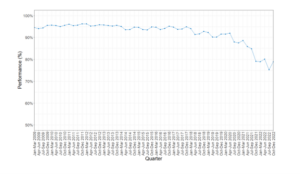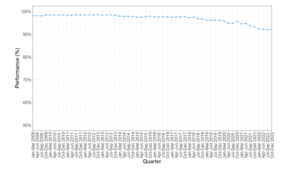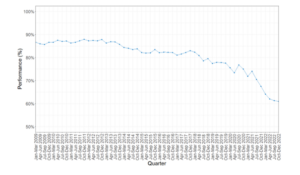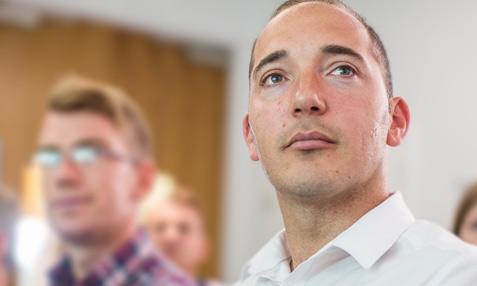
In 2000, the UK Government implemented the NHS Cancer Plan. This programme looked at prevention, diagnosis, treatment, care and research to review the NHS cancer strategy. Shorter waiting times ease patient anxiety and lead to an earlier diagnosis, quicker treatment, fewer complications and better outcomes.
As a result, access to diagnosis and treatment has evolved and we now have “the 62-day pathway”. This provides the following target timescales for diagnosis and treatment:
- 14 days – from the GP referral to first being seen by a specialist
- 28 days – from the GP referral to the patient being told they either do or do not have cancer
- 62 days – from GP referral to first treatment
These deadlines are ‘the operational standard’. 100% achievement is not expected. Patients may not be available for treatment in time, choose to delay treatment and there may be medical reasons not to treat them so quickly.
Compliance with target times is measured every 3 months and the findings are reported. The most recent report was released on 9th February 2023, for Quarter 3 (October to December) of 2022/2023. In summary, we are still falling behind the target treatment times.
The majority of diagnosis/treatment times have actually worsened but a few have improved slightly (see below). There is a lot more yet to do to get cancer diagnosis and treatment back on track.
The ”two week wait”
A patient with suspected cancer should be referred to and seen by a specialist within two weeks. The operational standard states that 93% of patients should be seen within this time frame.
In Quarter 3 of 2022/23 (October – December 2022), 717,013 patients were referred to and seen by specialists for suspected cancer. Of these, 78.9% were seen within 14 days, compared with 75.1% in Quarter 2 of 2022/23 (July – September 2022). In contrast, this was 79.1% at the same time last year (Quarter 3 2021/22). So overall, there is some improvement, but there is a slight decrease from the same period the previous year. Below is a graph which looks at this data. It shows the significant drop in hitting the target. This coincides with the pandemic but there was already a downwards trend before.

Source: Q3 – Cancer waiting times quarterly commentary (provider based) provisional.
31 day wait from diagnosis to first treatment
Patients should wait no longer than one month (31 days) from diagnosis to the start of treatment. The operational standard for this measure is 96%.
Between October and December 2022 (Quarter 3), 81,258 patients began their first definitive treatment for cancer. Of those, 92% started within the 31-day timescale, the same as 92% in Quarter 2 of 2022/23 and a slight decrease from Quarter 3 of 2021/22 which was 93.3%.
The proportion of patients who started treatment within the 31 days was lower for admitted patients (88.0%), compared to non-admitted patients (96.7%).

Source: Q3 – Cancer waiting times quarterly commentary (provider based) provisional.
In relation to different cancers, the percentage of patients who received their first treatment within 31 days is as follows:
– Breast cancers – 91.2%
– Lung cancers – 95.3%
– Lower gastrointestinal cancers – 91.1%
– Urological cancers – 92.2%
– Skin cancers – 87.9%
31 day wait for second or subsequent treatment
Patients should wait no longer than 31 days for a second or subsequent treatment. For quarter two 2022/23 and different treatment types, the data is broken down as follows:
– Anti-cancer drug regimen (chemotherapy, immunotherapy etc) – 98.3% were treated within 31 days. This is a slight increase from Quarter 2 at 98.2% but a decrease from 99% in 2021/22, which was above target at 99%. The target is 98%.
– Surgical Treatment – 81.2% of patients received their second or subsequent treatment within 31 days or fewer. This is the same as the 81.2% in Quarter 2 of 2022/23 but a drop from the 83.7% in the same period last year. The target is 94%.
– Radiotherapy – 90.6% of patients received their treatment within 31 days or fewer compared to the target of 94This is slightly better than the 90.3% in Quarter 2 of 2022/23, but a decrease from 94.6% in Quarter 3 of 2021/22.
62-day urgent referral to first treatment
The operational standard is that 85% of patients should wait no longer than 62 days to begin their first treatment. In Quarter 3, 44,793 patients began treatment following an urgent referral. 61% were within 62 days. This is a decrease on Quarter 2 (61.7%) and Quarter 3 of 2021/22 (67.6%). The graph below shows that this is a pattern that emerged far before the pandemic.

Source: Q3 – Cancer waiting times quarterly commentary (provider based) provisional.
Broken down by cancer type, the following patients received treatment within the 62-day guideline:
– Breast cancers – 71.1%
– Lung cancers – 52.1%
– Lower gestational cancers- 40.4%
– Urological cancers – 55.9%
– Skin cancers – 80.1%
Screening Services
In quarter three of 2022/23, 5,639 patients received treatment after a referral from screening. 69% were treated within 62 days. This is a drop from 74.1% in Quarter 3 of 2021/22 but remains the same as Quarter 2 of 2022/23.
Conclusion
In December of 2020, the Government launched the ‘Cancer Services Recovery Plan’. This aimed to restore cancer services following the interruption caused to it by the pandemic. It aimed to reduce patient waiting time and ensure sufficient capacity. The initial target date was March 2021, then March 2022 and now it has been pushed back until March 2023. Experts doubt we will hit the target by then.
There have been some improvements for those seen within two weeks after a referral. However, all the other categories are slightly worse.
Unfortunately, it will take some time and resources to get cancer referrals, diagnosis and treatment within these timeframes and we are not there yet. It will clearly take some time for a struggling service to catch up with pre-pandemic levels.
It is more important than ever to seek medical help if you have troubling symptoms to seek medical opinion. Cancer detected early is often easier to treat and may have a better outcome. Early diagnosis saves lives.
We are clinical negligence experts
Enable Law specialises in medical negligence, and we are here to advise and help you if you have concerns about the treatment of your cancer care. Should you have any concerns regarding your medical care, please contact us to speak with one of our specialist advisors.


















